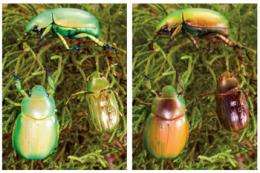Beetles stand out using Avatar tech

(PhysOrg.com) -- A new study suggests that jewel scarab beetles find each other -- and hide from their enemies -- using the same technology that creates the 3D effects for the blockbuster movie Avatar.
According to researchers from the University of Texas, the jewel scarab species Chrysina gloriosa can distinguish between circularly polarized and unpolarized light. That ability could provide the beetles with a tremendous advantage, the researchers say, because most of the light reflected off these beetles’ colorful bodies happens to be circularly polarized.
“The trait would allow the beetles to easily see each other while simultaneously hiding from predators that cannot see circular polarized light,” said physicist Parrish Brady, who conducted the research with Molly Cummings. Their research is published in the May issue of The American Naturalist.
Circular polarization (CP for short) is a way of filtering light that causes the light’s electric field to travel in a circular pattern, as opposed to oscillating in all directions as is does in unpolarized light. CP filters are now used to create 3D effects in movies, such as James Cameron’s Avatar. Human eyes don’t have the ability to perceive CP light, which is why we need special glasses to view films that use CP.
Scientists have known that jewel scarabs reflect CP light since the renowned physicist Albert Michelson discovered it in 1911. But to find out if they can also detect CP light (without the snazzy glasses), Parrish and Cummings took advantage of beetles’ propensity to fly toward light. Through a series of experiments, they tested to see if jewel scarabs alter their flight patterns in the presence of CP light.
“We found significant differences in the beetles’ flights toward circularly polarized and unpolarized light sources, suggesting that their eyes are outfitted to be sensitive to circularly polarized light,” Brady said.
The finding makes Chrysina gloriosa only the second species on Earth known to be sensitive to CP light—the other being a species of shrimp.
Because ability to see CP light is very rare in nature, it’s not likely that any of the beetles’ predators can see it. So the ability to both see and reflect CP light probably evolved to allow jewel scarabs to communicate with each other while staying hidden from predators, but Brady and Cummings are planning more research to see exactly how these beetles use this very rare way of seeing and being seen.
More information: Parrish Brady and Molly Cummings, “Differential Response to Circularly Polarized Light by the Jewel Scarab Beetle Chrysina gloriosa.” The American Naturalist 175:5 (May 2010). www.journals.uchicago.edu/doi/abs/10.1086/651593
Provided by University of Chicago


















